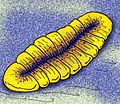Paleobiota
Unlike most other Ediacaran formations, the Blueflower Formation is unique in that is preserves shallow and deep-marine environments, and as it correlates with other Avalonian formations such as those in Newfoundland and Labrador, it allowed scientists to figure out whether the Ediacaran Biota started out in deep-marine environments before making their way into shallower waters. [1] The forms that can be found across the formation are the familiar Petalonamae such as Charniodiscus, including juvenile petalonamids from the Lower Member, and from the Upper Member tubular forms such as Annulatubus, and the enigmatic Windermeria. [1]
Color key
| Notes Uncertain or tentative taxa are in small text; |
Proarticulata
| Genus | Species | Notes | Images |
|---|---|---|---|
| Windermeria [4] [1] |
| Elongated motile organism. |  |
Petalonamae
| Genus | Species | Notes | Images |
|---|---|---|---|
| Charniodiscus [5] [1] |
| Frondose organism. |  |
| Juvenile Fronds [1] |
| Juvenile frondose organisms, exact genus affinities unknown. | |
| Pteridinium [6] |
| Frondose organism. |  |
Cnidarian
| Genus | Species | Notes | Images |
|---|---|---|---|
| Ediacaria [5] [7] |
| Discoid organism. |  |
| Kullingia [5] [7] |
| Discoid organism. | |
incertae sedis
| Genus | Species | Notes | Images |
|---|---|---|---|
| Annulatubus [3] |
| Tubular organism. | |
| Aspidella [1] [8] |
| Discoid organism. |  |
| Cyclomedusa [5] |
| Discoid organism. |  |
| Hiemalora [4] |
| Discoid organism, possibly holdfasts of petalonamids. |  |
| Sekwia [7] |
| Discoid organism. | |
| Sekwitubulus [3] |
| Tubular organism. | |
Flora
| Genus | Species | Notes | Images |
|---|---|---|---|
| Beltanelliformis [5] [1] [8] |
| Cyanobacterial colony. |  |
Ichnogenera
| Genus | Species | Notes | Images |
|---|---|---|---|
| Archaeonassa [3] |
| Burrows. |  |
| Gordia [5] |
| Burrows. | |
| Helminthoidichnites [7] [3] |
| Burrows. | |
| Helminthopsis [7] [3] |
| Burrows. |  |
| Planolites [7] [3] |
| Burrows. |  |
| Torrowangea [3] |
| Burrows. | |
Undescribed
| Genus | Species | Notes | Images |
|---|---|---|---|
| problematicum [1] |
| Curves and loops around, affinities unknown. | |